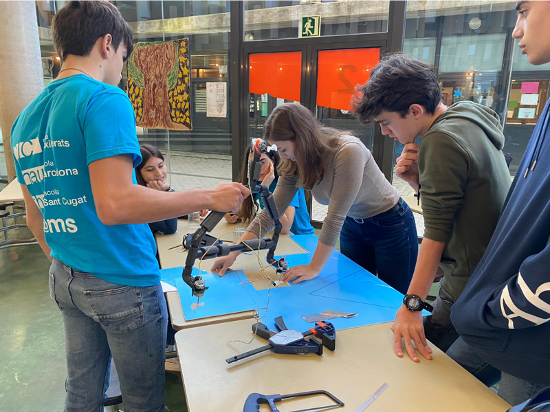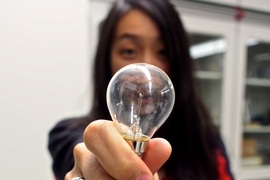“Meeting with the students [virtually] to discuss the challenges I had prepared was so inspiring because I saw the interest in science sparking during our conversations,” reflects Erick Eguia, a junior studying brain and cognitive sciences. Eguia had the unique experience of taking part in a longstanding MIT International Science and Technology Initiatives (MISTI) program in a new way — over Google Classroom to a group of eager students in Spain.
Typically during Independent Activities Period (IAP), MIT-Spain’s Global Teaching Labs (GTL) Program sends over 40 students to high schools across Spain and Andorra to share MIT's hands-on approach to STEM education. MIT students are, in turn, able to experience the diverse culture of Spain as well as practice their teaching, presentation, language, and problem-solving skills.
This year the program was reinvented and adapted due to Covid-19. MIT-Spain has collaborated with Fundació Tr@ms, a nonprofit foundation with a mission to bring knowledge of innovation and technology to classrooms and enrich Spanish educational communities, since 2017. Junior Erick Eguia, along with sophomores Michael Sutton (electrical engineering and computer science) and Victor Damptey (brain and cognitive sciences), partnered with Fundació Tr@ms to create online instructional courses and design models to deliver lessons, classes, and workshops virtually. Throughout IAP, they taught online at 11 different schools and reached over 1,800 students throughout Spain.
In total, the MIT team created 12 online modules across different STEM topics, including sustainability, chemistry, biology, and coding. The lesson plans were designed for three different age groups and were accompanied by challenges that further applied the Spanish students' learning around renewable energy, video game programming, waste management, and more.
“Fundació Tr@ms has been a fantastic partner that has exemplified a commitment to exploring new and unique teaching methodologies and approaches to student-centered learning," says Alicia Goldstein Raun, managing director of the MIT-Spain Program. “It was no surprise that Fundació Tr@ms reached out to develop a virtual GTL program.”
Raquel Fernandez, head of international projects, says that “Thanks to the collaboration with MIT-Spain over the years, Fundació Tr@ms and its associated schools have been able to access the GTL program in order to bring innovative methodologies from MIT directly to the classrooms. [Despite the program being virtual this year] MIT students bring expertise and knowledge, together with a personal impact that is extremely valuable to our students and teachers.”
Although the live sessions of the program ended in January, the created content is still being used through Fundació Tr@ms’ online portals, supplementing school curriculum. The impact of Eguia's, Sutton's, and Damptey's efforts continues to spark conversations and learning, reaching additional students across Spain. “This experience reminded me of the importance of looking to the future generations, and of scientific communication for everyone. In a moment where skepticism has grown to be unhealthy, education in the STEM fields seems to be the most potent antidote we have. I will make sure that the work I do is not only usable but understood by the people it will affect,” commented Eguia.
The MIT students tested their own subject knowledge and expertise as well as their teaching creativity. As Sutton states, “When I was making challenges, I wanted to have problems that were really hands-on and engaging, but I also wanted to be sure that students would be able to complete challenges while following Covid-19 safety guidelines while in class. This led to me spending hours researching fun and safe activities for students, which ultimately resulted in making all challenges completely online, but still as "hands-on" as possible.”
In addition to teaching, the MIT students shared what it was like to be a college student, specifically within the United States at MIT. The MIT students created a virtual “escape room” to give the Spanish students a tour of MIT’s campus while also quizzing them on their lessons. “I was able to share my experiences and interests with these students, which was an honor. If even one student had an interest sparked or is encouraged to apply to MIT, then this experience has been worth it … I also learned a lot about the cultural diversity within Spain," says Damptey.
The MISTI GTL Program offers a unique opportunity for MIT students to teach STEM subjects across the world and align with MIT’s “mind and hand” motto as well as the MIT Better World initiatives. Amanda, a participant from a previous GTL cohort, says, “I really enjoyed the opportunity to share my experiences and my knowledge and interests with others. I learned so much through talking with others and teaching at the school, and I think this experience has made me more informed and widened my views. I think I will have come out of GTL as a better teacher and a better person.”
“Hopefully, we will be able to reinstate the in-person program for IAP 2022, and more MIT students will be able to participate in GTL in Spain," says Goldstein Raun. "Meanwhile, thanks to the lesson planning and resources this cohort of students created, we already have a toolbox of useful and shareable materials.”
The MIT-Spain Program is sharing further plans for 2021 via their mailing list and Instagram. Students can apply for remote opportunities via Handshake. The program will also be taking part in a MISTI-wide celebration of all the remote collaborations for 2020-21, currently slated for late April. Student alumni will share their research and experiences and how they were able to connect internationally during this unique time.
"This program has taught me that another aspect of doing research is being able to share your work and passion with others. I will be sure to keep this in mind as I continue researching at MIT and beyond," remarks Damptey.











